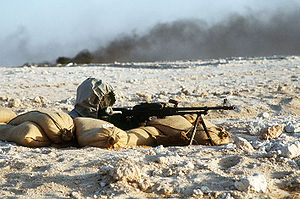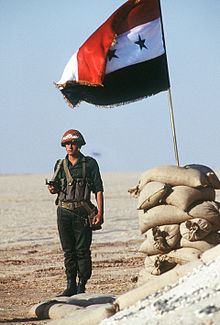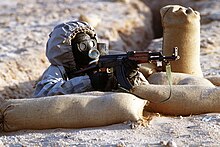Syrian Army
| Syrian Arab Army | |
|---|---|
| الجيش العربي السوري | |
 A Syrian soldier aims a 7.62mm PKM light machine gun from his position in a foxhole during a firepower demonstration, part of Operation Desert Shield. The soldier is wearing a nuclear-biological-chemical warfare mask. | |
| Founded | 1946 |
| Current form | 1971 |
| Headquarters | Damascus |
| Leadership | |
| President of Syria | Bashar al-Assad |
| Minister of Defence | Gen. Fahd Jassem al-Freij |
| Chief of Army Staff | Gen. Ali Ayoub[1] |
| Personnel | |
| Military age | 18 |
| Conscription | Mandatory for all males (2010 numbers pre-Syrian uprising) |
| Active personnel | 220,000[2] |
| Reserve personnel | 280,000[2] |
| Expenditure | |
| Budget | $1.8 billion (FY11)[2][3] |
| Percent of GDP | 3.5% (FY11)[2][3] |
| Industry | |
| Foreign suppliers | |
The Syrian Army, officially called the Syrian Arab Army, is the land force branch of the Syrian Armed Forces that supports the Ba'athist regime of Bashar al-Assad. It is currently engaged in a civil war against the Free Syrian Army, who seek to end the regime. It is the dominant military service of the four uniformed services, controlling the senior most posts in the armed forces, and has the greatest manpower, approximately 80 percent of the combined services. The Syrian Army was formed by the French after World War I, after the French obtained a mandate over the region.[5] In 1919 the French formed the fr:Troupes spéciales du Levant as part of the Army of the Levant. The former with 8,000 men later grew into both the Syrian and Lebanese armies. This force was used primarily as auxiliaries in support of French troops, and senior officer posts were held by Frenchmen, although Syrians were allowed to hold commissions below the rank of major.
History
As Syria gained independence in 1946, its leaders envisioned a division-sized army. The 1st Brigade was ready by the time of the Syrian war against Israel on May 15, 1948. It consisted of two infantry battalions and one armoured battalion. The 2nd Brigade was organized during the 1948 Arab-Israeli War and also included two infantry battalions and one armoured battalion.[6]
At the time of the 1948 Arab-Israeli War, the army was small, poorly armed, and poorly trained. 'Paris had relied primarily on French regulars to keep the peace in Syria and had neglected indigenous forces. Consequently, training was lackadaisical, discipline lax, and staff work almost unheard of. ...there were about 12,000 men in the Syrian army. These troops were mostly grouped into three infantry brigades and an armored force of about battalion size' writes Pollack.[7]
Between 1948 and 1967, a series of military coups destroyed the stability of the government and any remaining professionalism within the army. In March 1949, the chief of staff, General Husni al-Za'im, installed himself as president. Two more military dictators followed by December 1949. General Adib Shishakli then held power until deposed in the 1954 Syrian coup d'etat. Further coups followed, each attended by a purge of the officer corps to remove supporters of the losers from the force.[8] 'Discipline in the army broke down across the board as units and their commanders pledged their allegiance to different groups and parties. Indeed, by the late 1950s, the situation had become so bad that Syrian officers regularly disobeyed the orders of superiors who belonged to different ethnic or political groups' writes Pollack.[9] There was another 1966 Syrian coup d'etat.
However in 1967 the army did appear to have some strength. It had around 70,000 personnel, roughly 550 tanks and assault guns, 500 APCs, and nearly 300 artillery pieces.[10] The army had sixteen brigades: twelve infantry, two armoured, and two mechanised. The Syrian government deployed twelve of the sixteen brigades to the Golan, including both armoured brigades and one mechanised brigade. Three 'brigade groups', each comprising four brigades, were deployed: the 12th in the north, holding the sector from the B'nat Ya'acov bridge to the slopes of Mount Hermon, the 35th in the south from the B'nat Ya'acov bridge to the Yarmuk River border with Jordan, and the 42nd in reserve, earmarked for a theatre-level counterattack role.
During the Six Day War Israeli assault of the Golan heights, the Syrian army failed to counterattack the Israelis as the Israelis breached the Syrian positions. While Syrian units fought hard whenever the Israelis entered their fields of fire, no attempts appear to have been made to exploit Israeli disorientation and confusion during the initial assault.[11]
On 18 September 1970 the Syrian government became involved in Black September in Jordan when it sent a reinforced armoured brigade to aid the Palestinian Liberation Organisation.[12] Syrian armoured units crossed the border and overran Irbid with the help of local Palestinean forces. They encountered several Jordanian Army detachments, but rebuffed them without major difficulty. Two days later, the 5th Infantry Division, heavily reinforced, was also sent into Jordan. Two armoured brigades were attached to the division, bringing its' tank strength up to over 300 T-55s and its manpower to over 16,000. The division entered Jordan at ar-Ramtha, destroyed a company of Jordanian Centurion tanks there, and continued directly towards Amman. Pollack says it is likely that they intended to overthrow the Jordanian monarchy itself. Despite defeating the Jordanian Army at al-Ramtha on 21 September, after fierce air attacks on 22 September, the Syrians stopped the attack and began to retreat.

After 1970 further Syrian engagements included:
- Yom Kippur War against Israel[13]
- Lebanese Civil War (1975–1990), (against Lebanese militias, the PLO and Israel)
- 1982 Lebanon War (against Israel)
- Persian Gulf War (against Iraq)
- Syrian uprising (2011-present)
On 3 September 1994, Jane's Defence Weekly reported that then-President Hafez Assad had dismissed at least 16 senior military commanders. Among them was Major General Ali Haidar, then commander of the Special Forces, and General Shafiq Fayyadh, a cousin of the President who had commanded the 'crack' 3rd Armoured Division for nearly two decades. The 3rd Armoured Division was 'deployed around Damascus.' JDW commented that 'the Special Forces and the 3rd Armoured Division, along with the 1st Armoured Division are key elements in the security structure that protects Assad's regime. Any command changes involving those formations have considerable political significance.' Post-uprising reporting indicated the 1st Armoured Division had historically been at al-Kiswah and the 3rd Armoured Division was at al-Qutayfah.[14]
The Syrian armed forces have also been involved in suppressing dissident movements within Syria, for example by fighting a Muslim Brotherhood insurrection in the 1980s and attempting to put down a popular uprising in 2011 and 2012. However, the use of the army in an attempt to repress the current uprising has often been counterproductive; around 10,000 soldiers, including high-ranking officers, had defected or deserted as they were unhappy with orders to attack civilians.[15] But according to Rami Abdel Rahman, the head of the UK-based Syrian Observatory for Human Rights, they are less than 1000 soldiers that have deserted the army, he claim that the thousands defected soldiers announced are a 'false hope' *[16] Some defectors have actually formed the Free Syrian Army as the armed wing of the uprising[17] and engage in combat with security forces and soldiers around Syria.
However, by March 2012, many more soldiers, unhappy with crackdowns on pro-democracy protesters, switched sides and Turkish officials said that 60,000 soldiers had deserted the Syrian army, including 20,000 in one month. It was added that most of the deserters were junior officers and soldiers.[18] In June 2012 the UN head of peacekeeping said that Syria was in a state of "civil war" with the rebel Free Syrian Army trying to overthrow the current government controlled territory with the Syrian Army attempting to regain control of it.[19] In total, 40 Brigadier generals from the Army have defected to the opposition army, out of a total 1,200 generals.[20]
In 2010 army regulars were estimated at 220,000, with an additional 300,000 in reserve.[citation needed] The army had eleven divisional formations.[citation needed] The major development in force organization was the establishment of an additional divisional framework based on the special forces and the re-organization of active ground formations into three all arms army corps.[citation needed]
Structure in 2001
Parts of this article (those related to the structure section) need to be updated. (April 2012) |


- Three All Arms Army Corps HQ:
- 1st Corps HQ Damascus, covers from Golan Heights, the fortified zone and south to Der'a near the Jordanian border.
- 1st Armoured Division
- 3rd Armoured Division (Damascus)
- 9th Armoured Division (The 9th Armoured Division served in the 1991 Gulf War as the Arab Joint Forces Command North reserve and saw little action.)[21]
- 4th Mechanized Division
- 7th Mechanised Division
- 14th as-Saiqa Divisional Command HQ
- 2nd Corps HQ Zabadani, covers north of Damascus, to Homs and includes Lebanon.
- 10th Mechanised Division
- Seven independent Airborne Special Forces Regiments
- 3rd Corps HQ Aleppo, based in the north and covers Hama, the Turkish and Iraqi borders, the Mediterranean coastline and is tasked with protecting the complex of chemical and biological warfare and missile production and launch facilities. Maintains operational control over the Syrian Navy
- 5th Armoured Division (The 5th Division, at that time an infantry formation, invaded Jordan during the events of Black September in Jordan, 1970. It was reinforced with two armoured brigades. After an ineffectual defence by the massively outnumbered Jordanian 40th Armoured Brigade, the 5th Division's attack was repelled on 22 September 1970 mostly through the efforts of the Royal Jordanian Air Force.)[22]
- 6th Armoured Division
- 8th Armoured Division
- 11th Armoured Division
- 1st Corps HQ Damascus, covers from Golan Heights, the fortified zone and south to Der'a near the Jordanian border.
- Four independent Infantry Brigades
- Ten independent Airborne Special Forces Regiments (Seven regiments attached to 2nd Corps)
- Two independent Artillery Brigades
- Two independent Anti-tank Brigades
- Surface-to-surface Missile Command with three SSM Brigades (each with three SSM battalions),
- Three coastal defence missile brigades (Also they are strong rumors that Syria received C-802 systems and 100 missiles from Iran.):
- One brigade with 4 SS-C-1B Sepal launchers,
- One brigade with 6 P-15 Termit launchers, alternative designation SS-C-3 'Styx'
- One brigade with 6+ P-800 Oniks launchers,
- One Border Guard Brigade
Protecting Damascus:
- 4th Armoured Division (The Defense companies were transformed into the 569th Armoured Division, which then became the 4th Armoured Division.)[23]
- The Republican Guard Armoured Division:
- Three Armoured brigades
- One Mechanised brigade
- One Artillery regiment
The postulated reserve force structure in 2001 included:
- 2nd Armoured Division (Aleppo)
- 12th Motorized Division
- 13th Motorized Division
The two Motorized Division will be formed from the best of the following:
- Two Armoured Brigades
- Two independent Armoured Regiments
- Thirty Infantry Brigades
- Three Artillery Brigades
Reservists training are reasonable, but the equipment is old, of poor quality and limited in quantity.
Structure details made available from 2011
Human Rights Watch and Washington Institute reports seem to confirm the existence of the 15th Special Forces Division, which appears to have remained steadfastly loyal to the regime.
The European Council named Major General Wajih Mahmud as commander of the 18th Armoured Division in the Official Journal of the European Union on 15 November 2011, sanctioning him for violence committed in Homs.[24]
Equipment
- 10,885 Armoured Fighting Vehicles:
- 4,950 Main battle tanks (including 1,150 in storage)
- 1,125 Amphibious Armoured Scout Cars
- 2,950 Infantry fighting vehicles
- 1,860 Armoured personnel carriers
- 4,815+ Towed Artillery Pieces:
- 1,010+ Mortars
- 2,130+ Gun/Howitzers (400 in storage)
- 1,675+ Anti-aircraft guns (300+ in storage)
- 1,136 Self-Propelled Artillery Pieces:
- 485 Self-propelled howitzers
- 650 Self-propelled anti-aircraft guns (240 in storage)
- 6,890+ Anti Tank Guided Weapon Launchers (4,290 in storage)
- 500+ Multiple Launch Rocket Systems
- 102+ Surface to Surface/Ship Missile Launchers:
- 86+ Tactical ballistic missile launchers
- 16+ Anti-ship missile launchers
- 4,235+ Surface to Air Missile Launchers:
- 4,000+ MANPADS
- 235 Self-propelled air-defence systems
Uniforms and Rank Insignia, as of April 1987
Uniforms
Service uniforms for Syrian officers generally follow the British Army style, although army combat clothing follows the Soviet model. Each uniform has two coats: a long one for dress and a short jacket for informal wear. Army officer uniforms are khaki in summer, olive in winter. Certain Army (paratroops and special forces) and Air Defense Force personnel may wear camouflage uniforms. Air force officers have two uniforms for each season: a khaki and a light gray for summer and a dark blue and a light gray in winter. Naval officers wear white in summer and navy blue in winter while lower ranks wear the traditional bell bottoms and white blouse. The uniform for naval chief petty officers is a buttoned jacket, similar to that worn by United States chief petty officers. Officers have a variety of headgear, including a service cap, garrison cap, and beret (linen in summer and wool in winter). The color of the beret varies by season and according to the officer's unit.[25]
Ranks
Commissioned officers' rank insignia are identical for the army and air force. These are gold on a bright green shoulder board for the army and gold on a bright blue board for the air force. Officer ranks are standard, although the highest is the equivalent of lieutenant general, a rank held in 1986 only by the commander in chief and the minister of defense. Navy officer rank insignia are gold stripes worn on the lower sleeve. The highest-ranking officer in Syria's navy is the equivalent of lieutenant general. Army and air force rank for warrant officers is indicated by gold stars on an olive green shield worn on the upper left arm. Lower noncommissioned ranks are indicated by upright and inverted chevrons worn on the upper left arm.[25]
Awards
Although some twenty-five orders and medals are authorized, generally only senior officers and warrant officers wear medal ribbons. The following are some important Syrian awards: Order of Umayyads, Medal of Military Honor, the War Medal, Medal for Courage, Yarmuk Medal, Wounded in Action Medal, and Medal of March 8, 1963.[25]
References
| This image is available from the United States Library of Congress Prints and Photographs Division under the digital ID {{{id}}} This tag does not indicate the copyright status of the attached work. A normal copyright tag is still required. See Wikipedia:Copyrights for more information. |
- ^ http://arabic.upi.com/News/2012/07/22/UPI-27611342952533/
- ^ a b c d International Institute for Strategic Studies, The Military Balance 2010, p.272-273.
- ^ a b "Military Strength of Syria". Global Fire Power. Retrieved 2011-07-21.
- ^ "SIPRI Arms Transfers Database". Stockholm International Peace Research Institute. Retrieved 8 September 2011.
- ^ Pollack, 2002, p.447
- ^ Morris, Benny (2008), 1948: A History of the First Arab-Israeli War, p. 251. Yale University Press. ISBN 978-0-300-15112-1.
- ^ Kenneth Pollack, Arabs at War, 2002, p.448
- ^ Pollack, 2002, p.457-458
- ^ Pollack, 2002, p.458
- ^ Pollack, 2002, p.459-460
- ^ Pollack, 2002, p.464
- ^ Pollack, 2002, p.476-478
- ^ An order of battle of the Syrian Army in October 1973 can be found in Colonel Trevor Dupuy, Elusive Victory - The Arab-Israeli Wars 1947-74, MacDonald and Jane's, London, 1978
- ^ http://www.matthewaid.com/post/17259349392/is-the-syrian-army-falling-apart
- ^ http://www.haaretz.com/news/middle-east/over-10-000-soldiers-have-deserted-syria-army-says-high-ranking-defector-1.387494
- ^ http://www.aljazeera.com/indepth/features/2011/11/20111116154829885782.html
- ^ http://www.youtube.com/watch?v=C_oBV8dFDuI
- ^ http://www.bloomberg.com/news/2012-03-15/syria-loses-20-000-troops-as-deserters-flee-turkey-says-1-.html
- ^ http://www.bbc.co.uk/news/world-middle-east-18417952
- ^ Chief of protocol at the Syrian presidential palace defects: FSA
- ^ Norman Schwarzkopf, It Doesn't Take A Hero, Bantam Books, 1993, 467-9.
- ^ Pollack, Arabs at War, 2002, pp. 338-340.
- ^ http://gradworks.umi.com/3330856.pdf
- ^ Council Implementing Regulation (EU) No 1151/2011 of 14 November 2011 implementing Regulation (EU) No 442/2011 concerning restrictive measures in view of the situation in Syria, 14 November 2011
- ^ a b c http://lcweb2.loc.gov/cgi-bin/query/r?frd/cstdy:@field%28DOCID+sy0126%29
External links
- - Army Equipment
- Tom Cooper, Syrian Tank-Hunters in Lebanon, 1982, Air Combat Information Group
- See also unit listing drawn from Richard M. Bennett, The Syrian Military: A Primer, Middle East Intelligence Bulletin, August/September 2001.
Further reading
- Kenneth M. Pollack, Arabs at War: Military Effectiveness 1948-91, University of Nebraska Press, Lincoln and London, 2002, and Pollack's book reviewed: Brooks, Risa A. "Making Military Might: Why Do States Fail and Succeed? A Review Essay." International Security 28, no. 2 (Fall 2003): 149-191.
- History of the Syrian Arab Army: prussianization of the Arab Army, the Arab Revolt of 1916-1918, and the cult of nationalization of Arabs in the Levant after World War I, Infantry Magazine, Nov-Dec 2005.

